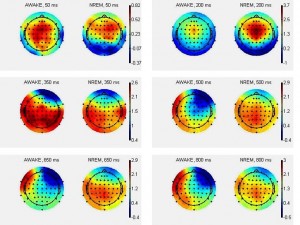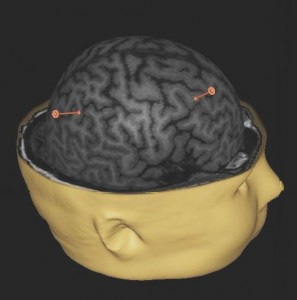Research
Research by the members of our lab can be conventionally divided into three stages. First (I), psychophysical and cognitive studies carried out by Talis Bachmann between 1975 and 1992 in the labs of Department of Psychology, University of Tartu, Department of Psychology, Vanderbilt University, and in the Moscow University. Second (II), during 1993-2006 when the core of the group was forming, aided by support from Tallinn University, grants from Estonian Science Foundation, targeted financing from Scientific Competency Council and the Estonian Center for Behavioral and Health Sciences. Third (III), since 2007 new rooms and new equipment have made it possible to supplement the primarily behavioral research based on psychophysical computer-aided visual perception and attention experiments with empirical cognitive neuroscience research based on modern equipment of neuronavigation and EEG/TMS.
While earlier research (I, II) consisted primarily of psychophysical experiments and their interpretation in terms of psychological (e.g., cognitive) information processing models, our current approach allows combine psychophysical/cognitive experiments with electrophysiological brain imaging and brain stimulation. Behavioral results become better interpretable in terms of the underlying brain mechanisms. A more detailed account of both earlier and current research can be found in the respective publications (please see Publications on this homepage).

From the stage III, some more recent research could be pointed out as follows.
We found that disruptive offline rTMS of the dorsolateral prefrontal cortex (DLPFC) either decreased propensity to deceptive responses or increased it, depending on the stimulation protocol and lateralized location of stimulation (Karton & Bachmann, 2011; Karton, Rinne & Bachmann, 2014; Karton, Palu, Jõks, & Bachmann, 2014). Similar rTMS was found to diminish the expression of the well known signature of deceptive responses, P300 (Karton & Bachmann, 2017). In collaboration with Jaanus Harro’s research group (University of Tartu, Institute of Psychology) we studied how biomarker platelet monoamine oxidase (MAO) activity could be related to risk taking as modelled by a game of skill (Otsa et al., 2016). In this game (Minimum-TBR, patented in Estonian Patent Office; registered with European Patent Office as Publication WO2004071596 (A1)), in order to obtain a really high score, players have to take some risk. It is known that individuals with propensity to risk tend to have low level platelet MAO activity. In our experiment, players with low MAO level scored better, showing that in certain circumstances propensity for risk may be beneficial. In a later study we found that manipulation of brain state by rTMS targeted at DLPFC changes frequency of risky action in the same game of skill (Tulviste & Bachmann, 2019). Our collaboration with Jaanus Harro’s group went on also in the studies of common genetic variability effects on visual metacontrast masking (e.g., Maksimov et al., 2013; Maksimov et al., 2015a, b; Maksimov et al., 2017). We showed that BDNF Val66Met, NRG1/rs6994992, 5-HTTLPR, and TPH2 variants interact with gender and target/mask shape congruency in determining how metacontrast masking is expressed. Genes expressed in dopaminergic and serotonergic brain systems influence basic visual perception processes unfolding along the fast time scale. Two important implications of these studies are that (i) simple psychophysical tests could be developed into screening methods for possible genetic vulnerability risks and (ii) any masking study purporting to find some general regularities of masking functions (and theories of masking based on masking functions) should use large samples of subjects in order to represent population and avoid idiosyncratic, ungeneralizable results that emerge due to a possible bias in the genotype of participant samples.
Comparing brain responses to long-interval (100 ms SOA) paired TMS pulses targeted to occipital cortex in the NREM sleep vs alert wakefulness we found that in the conscious state the slow large amplitude wave in response to the second pulse (registered in sleep) was suppressed in wakefulness (Stamm et al., 2015). This effect could be a basis for developing a TEP marker of consciousness states.
 Jointly with their German colleagues Lucia Melloni and Wolf Singer, Jaan Aru and Talis Bachmann have developed a novel approach stressing the need to distinguish between “true” NCC and the neural signatures marking prerequisite processes (NCCpr) and aftereffect processes (NCCae) preceding and following the “true” processes, the later being directly responsible for ongoing conscious experience. These ideas were suggested earlier by Talis (e.g., Bachmann, 2000, 2009) and Lucia Melloni, but the collective effort culminated in a highly cited paper published in Neuroscience and Biobehavioral Reviews (Aru et al., 2012). To continue the debate on the NCC, Jaan and Talis launched a Research Topic in Frontiers in Psychology (Consciousness Research) in 2014, with prominent contributors such as Biyu He, Anthony Hudetz, Bernard Baars, Nikos Logothetis, Michael Pitts, Steven Hillyard, Quian Quiroga, Morten Overgaard and many others (see Aru & Bachmann, 2015). Our group supports the evidence based conceptualization of attention and consciousness as mutually autonomous, however interacting processes (e.g., Bachmann, 2006; Murd & Bachmann, 2011; Aru & Bachmann, 2013), empirically supported notion of interacting mechanisms for content vs level aspects of consciousness (Bachmann, 2011, 2012, 2013a,b, 2014; Bachmann & Hudetz, 2014). A hypothetical involvement of the (sub)cellular level BAC firing mechanisms of apical amplification in producing visual spatiotemporal phenomena was also suggested (Bachmann, 2015), followed by the general conceptualization of how this mechanism may be involved in producing states of consciousness (Phillips, Bachmann, & Storm, 2018). The two-compartment model of layer-5 pyramidal neurons as the mechanism by which sensory input and top-down contextual modulation interact to produce conscious experience seems to have a powerful capacity for interpreting data from anesthetic effects as well as conscious perception effects.
Jointly with their German colleagues Lucia Melloni and Wolf Singer, Jaan Aru and Talis Bachmann have developed a novel approach stressing the need to distinguish between “true” NCC and the neural signatures marking prerequisite processes (NCCpr) and aftereffect processes (NCCae) preceding and following the “true” processes, the later being directly responsible for ongoing conscious experience. These ideas were suggested earlier by Talis (e.g., Bachmann, 2000, 2009) and Lucia Melloni, but the collective effort culminated in a highly cited paper published in Neuroscience and Biobehavioral Reviews (Aru et al., 2012). To continue the debate on the NCC, Jaan and Talis launched a Research Topic in Frontiers in Psychology (Consciousness Research) in 2014, with prominent contributors such as Biyu He, Anthony Hudetz, Bernard Baars, Nikos Logothetis, Michael Pitts, Steven Hillyard, Quian Quiroga, Morten Overgaard and many others (see Aru & Bachmann, 2015). Our group supports the evidence based conceptualization of attention and consciousness as mutually autonomous, however interacting processes (e.g., Bachmann, 2006; Murd & Bachmann, 2011; Aru & Bachmann, 2013), empirically supported notion of interacting mechanisms for content vs level aspects of consciousness (Bachmann, 2011, 2012, 2013a,b, 2014; Bachmann & Hudetz, 2014). A hypothetical involvement of the (sub)cellular level BAC firing mechanisms of apical amplification in producing visual spatiotemporal phenomena was also suggested (Bachmann, 2015), followed by the general conceptualization of how this mechanism may be involved in producing states of consciousness (Phillips, Bachmann, & Storm, 2018). The two-compartment model of layer-5 pyramidal neurons as the mechanism by which sensory input and top-down contextual modulation interact to produce conscious experience seems to have a powerful capacity for interpreting data from anesthetic effects as well as conscious perception effects.
Over a few recent years several studies central to our team’s consciousness research interests were conducted by Renate Rutiku in collaboration with other colleagues (Rutiku et al., 2015, 2016). We showed that when instead of a typically used set of stimuli belonging to a narrow class of visual objects a very widely varying set of stimuli is used (a suggestion from Talis), both N200 and P300b are reliable general markers of conscious perception unspecific for stimulus category. On the other hand, the same markers came to the fore also when only a well predictive, invariant, perithreshold stimulus was used. P300b is not the only and earliest NCC. Interestingly, as what came out of the ideas by Jaan Aru and Renate Rutiku, the variance of the consciousness markers obtained in the contrastive ERP analysis was substantially accounted for by the EEG signals recorded in the unconscious trials.
More recent studies have brought support for the views of phenomenal overflow (e.g., in iconic memory), dissociation of attention and visual awareness, emergence of expectation based illusory perception (“hallucinations”), dependence of the proneness to hallucination on individual differences (e.g., autistic traits), and lack of a general factor of the proneness to the strong dependence on priors in perception as assessed by different paradigms (Bachmann, T., & Aru, J. (2015, 2016; Aru & Bachmann, 2017; Aru, Tulver, & Bachmann, 2018; Tulver et al., 2019).
Other research directions and findings can be found in our Publications list.
